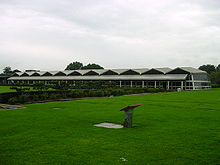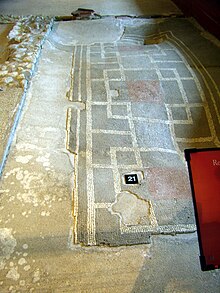Fishbourne Roman Palace
Fishbourne Roman Palace (German "Roman Palace in Fishbourne") is an archaeological museum in the southern English town of Fishbourne , West Sussex .
history
In 1960, when a water pipe was being built in the village of Fishbourne, the remains of a large Roman villa were found, some of which were excavated by Barry Cunliffe in the following years and which is one of the largest Roman villas north of the Alps .
The oldest remains here date from shortly after 43 AD, when England was conquered by the Romans. They are wooden barracks that probably came from a military camp. Two buildings were found, and posts were found that were parallel to one another in several rows. These posts can hardly represent the walls of ancient buildings, instead they are in all likelihood supports for a platform. Only at the north end were there no posts inside the building, only at the place of the walls. The whole structure may have been a granary that had to stand on a raised platform to keep the grain dry. In the north there seems to have been an extra room that was not on a platform and where the grain or other food could be loaded and unloaded.
In the Neronian period, civilian settlement apparently started here and around 60 a first large stone building was erected. These buildings are poorly preserved, but a large courtyard and a bathing area have been found.
The Flavian Palace
Between 75 and 80 the Neronian building was torn down and replaced by a large villa , which can also be called a palace . The palace was entered from the east through a column decorated gate and a gate hall behind it. Four columns adorned the facade and four more stood in the actual entrance hall. There was a large pool of water at the end of the hall. From there you got into a large garden around which the whole building complex was grouped.
The west wing, exactly opposite the entrance, was undoubtedly the center of the complex. The importance of this part of the building can also be seen from the fact that it was built on a 1.5 m high terrace. Unfortunately, this also meant that this part of the building was particularly exposed to the weather over the centuries and is therefore worse preserved than other parts. In the center of the west wing, a large hall was placed exactly in the axis of the building and opposite the entrance. It was 10.6 mx 9.4 m with a 6 m wide apse on the rear wall. The floor of this hall was already badly damaged, but small fragments of a mosaic floor with particularly small stones were found, which prove that a mosaic of particularly high quality was laid here. A wooden bench once stood on the walls of the apse, the prints of which could still be seen on the wall. The facade of this hall was adorned by four columns that were once probably 7.6 m high. There was also a staircase here that led to the terrace of the west wing. This hall was the center of the west wing of the palace. Only the parts north of the audience hall have been excavated so far. It's a series of rooms, all decorated with geometric black and white mosaics. Two groups of rooms can be distinguished that were not connected to each other, but apparently had doors to the garden. The rooms were once richly painted.
West wing
The west wing was the center of the palace complex. It was the part of the complex that was seen immediately, and probably also the part that housed the main administrative rooms. This part was built on a slightly raised ground and thus towered over the rest of the complex by a little more than a meter. A little more than half of the rooms could be excavated. Due to the elevated location, this part of the palace was less protected by earth and therefore particularly exposed to agriculture in the Middle Ages, which is why it is comparatively poorly preserved.
The center of the west wing formed a hall with an apse, which was exactly in the axis of the palace, opposite the main entrance. With some certainty it was the audience hall. The floor of the hall once had a mosaic, of which only a few remains were found. These show particularly small mosaic stones and thus indicate a high quality.
North wing
The north wing consisted of a large number of rooms (N1-N24) grouped around two peristyle . The peristyle, in turn, opened to the south to the large central garden of the palace complex. In the north wing there were apparently various richly furnished residential units. The first of them consisted of five rooms (N1-N5). The largest room (N1) was once furnished with a black and white, geometric mosaic, of which only a few remains have survived, as hypocausts were built on the mosaic in the second century . Another room (N3) was again laid out with a black and white, geometric mosaic. Here you can find squares filled with at least three types of patterns and connected by a network of lines. A third room in this residential wing shows a simple pattern of black squares and white rectangles.
To the east of this residential wing was the first peristyle and on the north side another large room (N7), which was flanked by two small elongated rooms. The large room may have been a dining room. The function of the two small flanking rooms is unknown, but they were probably rooms that were connected to the large dining room. The large room was decorated with a mosaic that showed 16 squares in the center, which were filled with different patterns. The frame shows a wall with gates. From the rubble that filled the room, there are remains of a stucco frieze that probably closed the wall to the ceiling. It shows a pair of birds in front of a vessel. Underneath there is a so-called pearl cord . Such stucco friezes are known from Italy, but so far only documented in this palace in Britain and underline the special importance of this complex. This room was decorated with panels inlaid in marble. The marble used came from almost all parts of the Roman Empire. There was Purbeck Marble , a gray marble, perhaps from the Isle of Purbeck . Other varieties came from today's Turkey, but also from Greece from the island of Skyros .
The middle residential unit (N9 – N14) has an L-shaped room / corridor (N14) in the center, from which the entrances to the actual living rooms once opened. The floor of this corridor was once decorated with a mosaic, of which only minimal remains have been found. The same goes for the three smaller rooms to the north of the corridor. The wall paintings in room N9 are noteworthy; they were still found in large fragments on the floor and probably date to the Flavian period and thus belong to the original furnishings of the palace. The paintings showed a pedestal about one meter high that imitated pink-red marble. This painted marble was separated by black fields. The main wall showed a field decoration, with some fields again copied colored marble, while the others showed a rather simple marble in orange. Room N10 was the middle of the three north and seems to have been richly decorated with marble. The two southern rooms were also covered with a mosaic. Only small parts of the floor in room N13 can be seen today. The mosaic in room N12 is much better preserved, as another mosaic was never laid. The floor shows a series of crosses and squares, which are in turn connected by black lines that simulate a vague spatiality. In the crosses there are either rows of triangles or black bars. The squares show various interior patterns. The wall paintings in this room can also be reconstructed to a certain extent, as the walls apparently were not painted over after the Flavian period. The walls, in turn, had a base zone that was painted red and pink and apparently was supposed to imitate granite. Panels were painted over this again, apparently also copying exotic stones.
To the east of the middle residential unit there is another peristyle, next to which there is a large dining room (N16). This part of the building suffered particularly from subsequent renovations, which is why hardly anything of the original furnishings has been preserved. In the far east is the third residential unit in the north wing of the building, which consists of six rooms: four smaller ones on the west side and two larger ones in the east. Only three of the smaller rooms have preserved parts of the original mosaic furnishings. The mosaic in room N21 is black with a geometric pattern in white and red squares. At the edge of the mosaic there is a small diamond-shaped stone as part of the mosaic. Maybe that's a signature of the artist. Room N21 may have served as an anteroom for room N23.
The mosaics
The palace's black and white mosaics are among the earliest in England and may have been made by a workshop or craftsman from Italy. You have few comparative examples in England. A mosaic is very similar to one from Besançon and underlines the assumption that the craftsmen came from outside.
owner
The owner of the facility was almost certainly King Tiberius Claudius Cogidubnus . This is mentioned by Tacitus as a vassal king under Vespasian in Britain and is also known from an inscription that was found in today's neighboring Chichester , which was probably his capital.
After the death of Cogidubnus, the administration in this area passed completely into Roman hands. As a result, the palace was no longer needed, and various alterations can be found that indicate that the building passed to different owners who shared the building. The building finally burned down around 280 and was never rebuilt afterwards.
Others
The villa is the setting of a novel by Lindsey Davis ( A Body in the Bath House, "A body in the bathhouse" German), the skeletal Fund in hypocausts picks Fishbourne.
literature
- Barry Cunliffe : Fishbourne, A Roman Palace and Its Garden. Thames and Hudson, London 1971, ISBN 0-500-27015-5 .
- David S. Neal, Stephen R. Cosh: Roman Mosaics of Britain. Volume III: South-East Britain, Part 2. London 2009, ISBN 978-085431-289-4 , pp. 527-553.
Web links
- Fishbourne Roman Palace (English)
- Fishbourne Palace - Romans in Sussex (English)
- Villa Regis Cogidvbni. In: Roman-Britain.org. Retrieved July 28, 2009 .
Individual evidence
- ^ Barry Cunliffe: Fishbourne, A Roman Palace and Its Garden. Pp. 29-30.
- ^ Barry Cunliffe: Fishbourne, A Roman Palace and Its Garden. Pp. 76-98.
- ^ Barry Cunliffe: Fishbourne, A Roman Palace and Its Garden. Pp. 108-109.
- ^ Barry Cunliffe: Fishbourne, A Roman Palace and Its Garden. P. 109.
- ^ Barry Cunliffe: Fishbourne, A Roman Palace and Its Garden. Pp. 109-111.
- ^ Barry Cunliffe: Fishbourne, A Roman Palace and Its Garden. P. 116.
Coordinates: 50 ° 50 ′ 11.9 " N , 0 ° 48 ′ 35" W.












